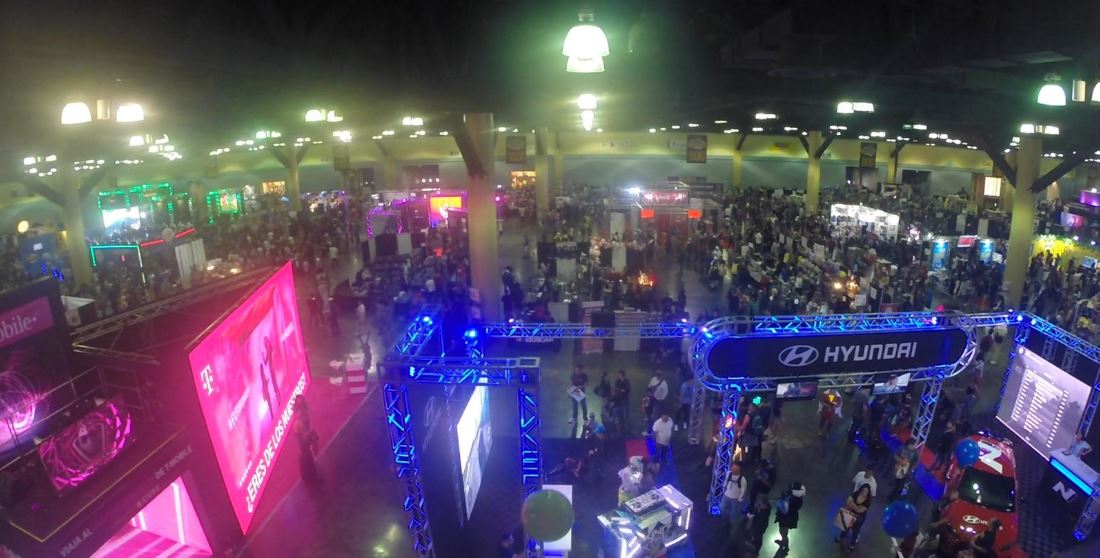
As the 17th annual Puerto Rico Comic Con closed its doors on May 19th one thing was clear: the future of the convention lies in its Artist Alley.
Puerto Rico’s comics scene has a very fractured history, often taken as a struggle for recognition given the American market’s hold on weekly comic book sales. As is the case in most independent comic book communities, competing for attention against publishers that release their books on a regularly basis already puts local creators in a tough spot.
Artist Alley’s at conventions, then, become powerful platforms for local creators. It allows them to not only get more eyes on their work but get the opportunity to develop a more reasonable release model that promises new content each year. It’s not always ideal, but it can establish content continuity for fans of specific local artists or emerging creators.
In an interview for The Beat, PRCC’s executive producer Ricardo Carrión expressed an interest in expanding their Artist Alley as creators are succeeding in building up their own fan base. People are starting to come to the convention looking for specific artists in addition to new ones they can start following.
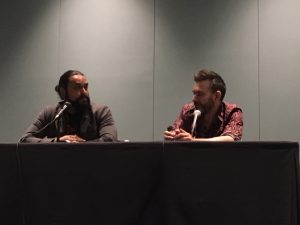
This wasn’t always the case, but Puerto Rico’s other conventions have done such a great job of establishing newcomers and their work as part of a more coherent comics community that indie comics are no longer seen as a novelty or a curiosity. They are now seen as a bigger and more serious part of the industry. Puerto Rico Comic Con is building upon this, which is why next year’s show should make the Alley’s expansion top priority.
This year’s convention showcased some of Puerto Rico’s top local talent, but I would have liked to see more talks, panels, and even workshops centered around them. And the interest is there. According to associate producer Finees Almenas, local podcast and content creator panels attracted large audiences, proving fans are willing to support homegrown projects.
I had the chance to participate in a panel about fandoms, their levels of toxicity in social media, and what it takes to be a healthy and responsible fan. The panel was developed by Cultura Secuencial, a local podcast about pop culture from a Puerto Rican perspective, and it gathered one of the largest crowds in the con (full disclosure: I have a good relationship with the podcast’s team as one of its members, Gabriel Alejandro, is the co-creator of Se Habla Comics, a podcast about comics for Spanish-speakers in which I also serve as co-creator).
A Young Adult author panel organized by The Bookmark, a local bookshop, also received strong fan approval, especially given its interactive video conference setup. Authors Becky Albertalli (Simon vs. The Homo Sapiens Agenda) and Kendra Blake (Three Dark Crowns) were able to discuss their stories with readers without mayor setbacks and word on the show floor was one of approval and excitement.
The biggest takeaway from this year’s Puerto Rico Comic Con is that there seems to be a genuine interest in supporting creative projects born and bred in Puerto Rico. Local comic booths had a steady stream of traffic and the interactions between creators and readers was indicative of a need, a hunger even, for more locally-crafted pop culture creations with big “made in Puerto Rico” stamps plastered all over them.
Here’s a look at just some of the creators that represented the exponentially growing local comics scene at Puerto Rico Comic Con’s Artist Alley. I asked each creator to give me their take on the local comics scene and how they’ve approached it.
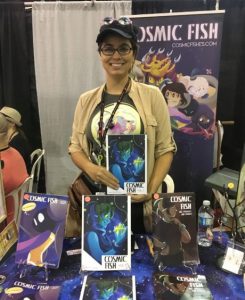
(http://cosmicfishes.com/, Instagram: @cosmographiarte)
Creator of the award-winning webcomic series Cosmic Fish, Eliana is focused on integrating Puerto Rican myths and folklore into the larger Fantasy genre. Her comics excel in world building and the characters that populate her stories are intricately researched. Eliana featured the softcover edition of Cosmic Fish at her booth, which collected the first grand arc of the series. Her work is also featured in the Eisner-nominated anthology Puerto Rico Strong.
Eliana: This year’s convention is definitely showing how much we’ve grown in developing a fan base for local talent. I’ve had people come up to me specifically looking for Cosmic Fish and saying that it’s their favorite character. I’ve had fans come up and talk about the monsters, creatures, and ghosts found in the story. That’s what Artist Alleys do. They extend our reach and our audience. We have some ways to go in terms of shining a better light on the Artist Alley at the convention floor as it competes with the flashier and louder parts of the con, but we have a pretty good support system among artists and the fans are giving us their support. We’re still taking baby steps, but we’re getting there.
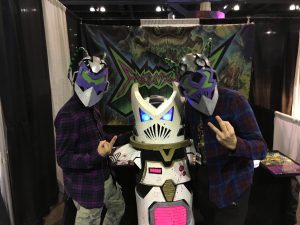
(https://fullminatorofficial.bandcamp.com/, Instagram: @fulminator_official)
Fullminator is a thrash metal band from Orocovis, PR that chose to take a different route with the release of their new album CRACKATTACK: they turned the compact disk’s accompanying booklet into a scifi comic book detailing the cosmic origins of the band. The story takes from the best parts of b-movie creature designs and gratuitously delves into an epic story of clones, alcohol, robots, and drugs. They will be releasing American tour dates in the coming months.
Fullminator: Our show is very theatrical. We have robots shooting lasers and bringing us beer as we do our thing, but it’s all tied to the story. We went for the comic book because we wanted to get our fans into the show by attacking all of their senses. The comic’s gotten a good amount of attention and people are always coming up for pictures with us and our Crack Bot. We wanted to take advantage of the convention to put something out there that’s in the same wavelength as the event’s.
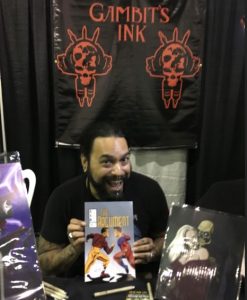
(https://gambitsink.com/, Instagram: @gambitsink)
Elías Meléndez can easily be considered one of PRCC’s more experienced art-by-commission and comic book creators, in addition to his cosplaying experience in the years leading up to his Artist Alley appearances. Known by most as Gambit, Elías is the co-creator, along with Aníbal Delgado, of Unos 30 Tiros, about a vigilante taking on Puerto Rico’s crime rate one bullet at a time. For this year’s show, Elías featured his new comic The Argument, about a superhero and his sidekick settling an argument by way of fists, which is loosely based on a true story. Elías is also a tattoo artist currently working out of Florida.
Elías: There’s always been a comics presence in Puerto Rico’s convention scene, which has been through some really bad times but also through some really good times. I would say we’re in a good spot right now. I’ve noticed a particularly marked comics presence in the last five years of the convention. I think one of the things the convention has done well is inspire us creators to become better at our craft. I look at other booths in the Alley and it just makes me want to get to their level. I want to be as good as them. It’s a healthy kind of competition, because it’s not about becoming better than everyone else to walk all over other creators. It’s about representing Puerto Rico’s comic scene in the best way possible as a community. Last year I spoke to a kid that bought one of my comics and said he wanted to create his own. This year he has his own booth. And that’s something I want to see happening more and more.
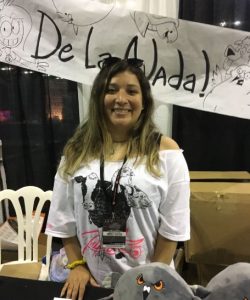
(http://tripleta.com/politipunch/, Instagram: @radrangy)
Rangy’s De La Nada! animated series has become wildly successful in Puerto Rico for its bitingly smart take on local politics and news stories. She has developed her own brand of political satire by taking the classical political cartoon format and infusing it with modern comic book sensibilities. For this year’s Puerto Rico Comic Con, Rangy released a new card game based on her political cartoons called PolitiPunch. It can best be described as Pokemon meets The Daily Show. It’s so funny it’s scary, mostly because it captures the actual ridiculousness of Puerto Rican politics so accurately. Rangy’s currently working on her new project, NonPack.
Rangy: I’ve always been inspired by political satire. I mean, I got informed by the likes of Jon Stewart, Stephen Colbert and Samantha Bee. While making my own comics, I looked at how they approached the news and tried to give it my own spin. The important thing was capturing the comedy behind the political, so that people could learn about politics the way I did, by laughing. From that came Politipunch. The response here at PRCC has been great and people come up to look at the cards and laugh at the fighting powers each politician has by linking them to actual headlines. I’m just happy people are really getting into it because they are learning about our government and how it treats its people.
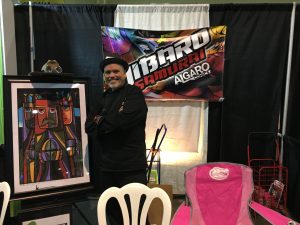
(Facebook: @jibarosamurai, Instagram: @guelopicabuu)
Jíbaro Samurai is one of the most recognized indie comics in Puerto Rico. Its creator, known by all as simply Sanjurjo, is one of the biggest creators and supporters of comics in Puerto Rico. In a sense, he’s seen it all in his more than 10 years experience in the local comics scene. He’s seen groups of comic book readers ignore local talent and he’s seen them embrace it years later. He’s seen local comics fight for recognition and then be recognized for getting to the point in which they are today. His Japanese-inspired comic, Jíbaro Samurai, has a dedicated following that come for the pop culture references and the samurai action but stay for the intensely Puerto Rican story beats it develops. Sanjurjo presented several anniversary editions of his comic at the convention.
Sanjurjo: Compared to how hard it was to publish a comic on your own dime some 15 years ago, new creators have more tools for putting quality work out there quick, and loudly. There’s really no excuse. We can make comics now. I do think the monthly comics model is a hard one to maintain in our indie market. I would recommend a meatier story, 50 pages or more, tell a big chunk of the story and then hype up the coming chapter. Having said that, making comics on your own is tough, torturous even as it really does cost sweat, blood, and tears to see your comics get to people’s hands. I’ve been celebrating Jíbaro Samurai’s anniversary for a few years now and people at the convention really appreciate it. People expect quality and I take it to heart. I want my comic to look and feel like a real quality product. And they’ll get it, especially now that our Jíbaro is going to space!
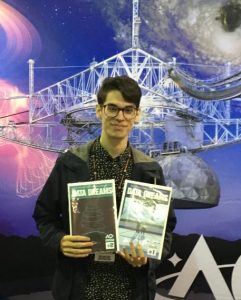
(https://www.naic.edu/ao/landing, Twitter: @NAICobservatory)
Puerto Rico is home to one of the world’s most powerful radio-radar telescopes, located in the town of Arecibo (which is featured in the final action set-piece of GoldenEye, where James Bond fights a rogue agent right on top of it). The Arecibo Observatory, to the surprise of many, decided to publish a comic book about its history. William González Sierra was responsible for the pitch that made this project come to life. The comic’s titled Data Dreams and it not only tells the story of the Observatory and its founder Bill Gordon, but it also introduces Greg, the Observatory’s new AI mascot. William had issues 1 and 2 on display at his booth.
William: I thought it would be a good idea to just pitch the idea of a comic book history of the Observatory with the introduction of a new mascot, Greg, which is kind of like a glorified hard drive that becomes Bill Gordon’s historian. The Observatory was interested in developing the story as it could get more kids into science and from there on I worked on Data Dreams. There’s an obvious fictional element with Greg, but the story features real scientists from both the past and the present and readers can get acquainted with them. There was some resistance in the beginning, but the idea took off and here we are. Everyone at the Observatory helped with the research process, allowed me to sit in during scientific discussions and people here at the convention seem to be liking the comic.
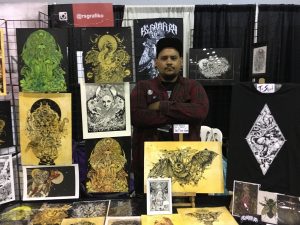
(Instagram: @rsgrafiko)
Ricardo Sánchez has one of the most visceral and distinctive art styles in Puerto Rico. Period. His work is a mix of highly intricate designs fused with Heavy Metal and Punk imagery. There’s a sense of the macabre to his art, but it never veers off into the simplistic. Whether it’s animals surrounded by violent nature or pop culture icons explored with an obsessive amount of detail, Sánchez approaches art as an appreciation of the elements that make up life, death, and the more obscure parts that fall between them. His booth at the convention felt more like an intimate art exhibit than a regular comics booth, but his work was accessible to all and he enjoyed talking to everyone who came up to look at his work. Ricardo Sánchez is also a tattoo artist.
Ricardo: When I start sketching I’m not necessarily thinking about how’d it look as a tattoo. That’s a whole other thought process. I have to think about size and about how much detail can be crammed into something that gets inked into someone else’s skin. Although I say my ideas come from music like Metal and Punk, I read a lot about politics, social issues, and religion. They all figure into my designs. And they also respond to the changing local art scene. It’s not the same as before. That’s why I’m looking to create my own exhibit, present my work, and see where I can show my art next. People have really supported my stuff ever since I started coming to the convention. I had my own corner, I read the room, got the flow of the con, and then it was a matter of putting the work in. I just really love what I’m doing and am eager to share it with others.
Additional photography by Gabriel Alejandro.


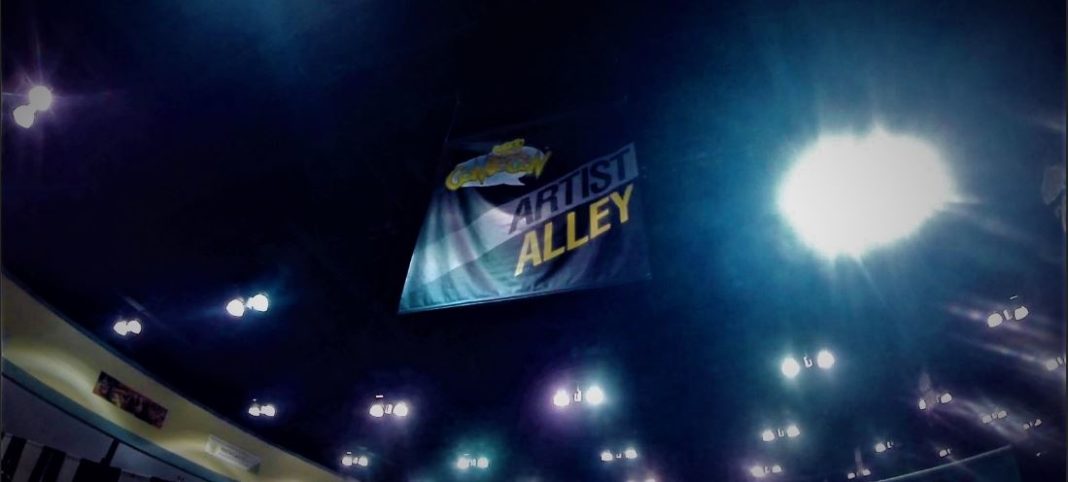
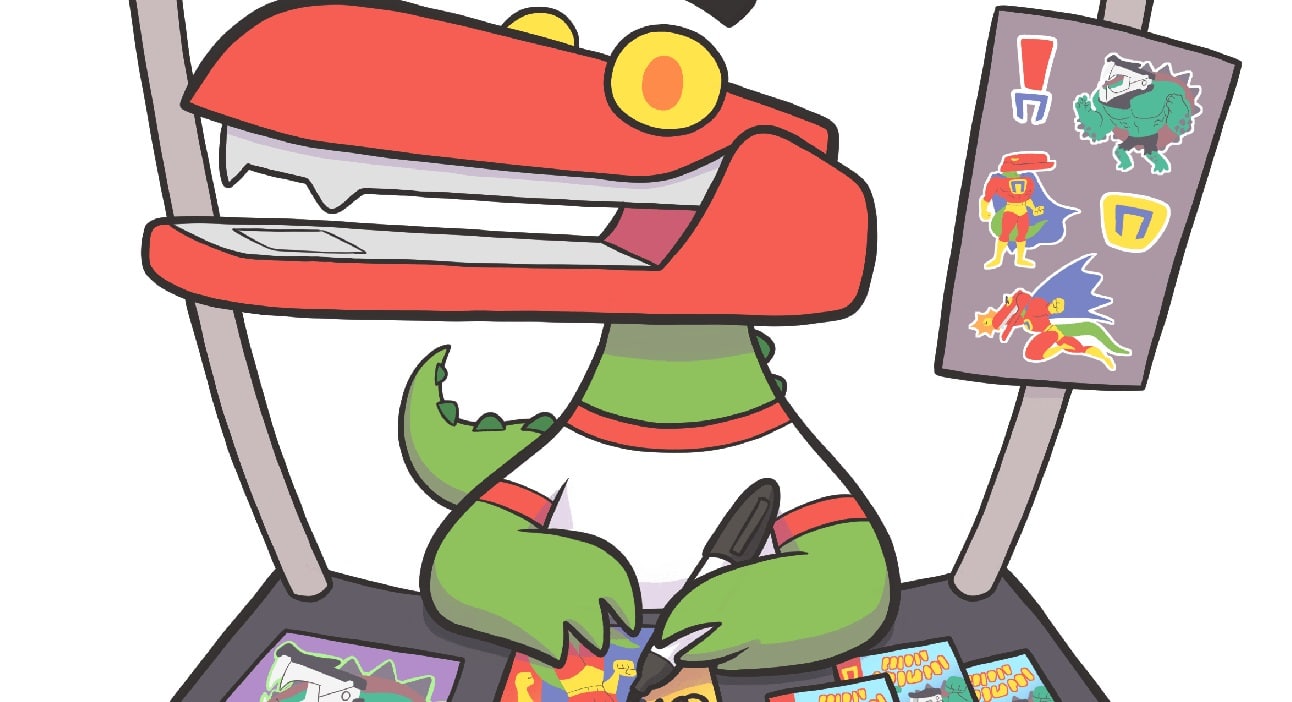

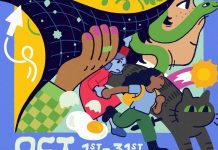


There’s nothing better than supporting “local” comic artists that look like white American hipsters and make comics that are indistinguishable from what the typical white American hipster makes.
“: I’ve always been inspired by political satire. I mean, I got informed by the likes of Jon Stewart, Stephen Colbert and Samantha Bee” Nothing is more Puerto Rican than John Steward and Stephen Colbert. Those satirists routinely mock the white men keeping Puetro Ricans from living as well as American white hipsters.
Comments are closed.